NVIDIA’s GeForce GTX 480 and GTX 470: 6 Months Late, Was It Worth the Wait?
by Ryan Smith on March 26, 2010 7:00 PM EST- Posted in
- GPUs
The GF100 Recap
NVIDIA first unveiled its GF100 (then called Fermi) architecture last September. If you've read our Fermi and GF100 architecture articles, you can skip this part. Otherwise, here's a quick refresher on how this clock ticks.
First, let’s refresh the basics. NVIDIA’s GeForce GTX 480 and 470 are based on the GF100 chip, the gaming version of what was originally introduced last September as Fermi. GF100 goes into GeForces and Fermi goes into Tesla cards. But fundamentally the two chips are the same.
At a high level, GF100 just looks like a bigger GT200, however a lot has changed. It starts at the front end. Prior to GF100 NVIDIA had a large unified front end that handled all thread scheduling for the chip, setup, rasterization and z-culling. Here’s the diagram we made for GT200 showing that:
NVIDIA's GT200
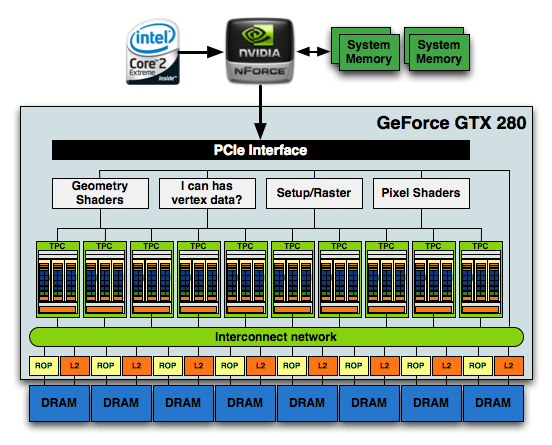
The grey boxes up top were shared by all of the compute clusters in the chip below. In GF100, the majority of that unified front end is chopped up and moved further down the pipeline. With the exception of the thread scheduling engine, everything else decreases in size, increases in quantity and moves down closer to the execution hardware. It makes sense. The larger these chips get, the harder it is to have big unified blocks feeding everything.
In the old days NVIDIA took a bunch of cores, gave them a cache, some shared memory and a couple of special function units and called the whole construct a Streaming Multiprocessor (SM). The GT200 took three of these SMs, added texture units and an L1 texture cache (as well as some scheduling hardware) and called it a Texture/Processor Cluster. The old GeForce GTX 280 had 10 of these TPCs and that’s what made up the execution engine of the GPU.
NVIDIA's GF100
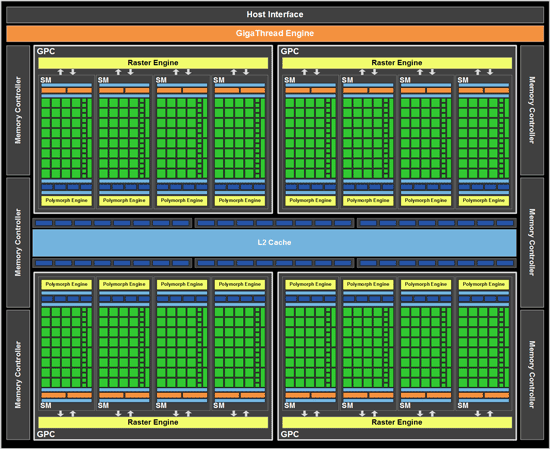
Click to Enlarge
With GF100, the TPC is gone. It’s now a Graphics Processing Cluster (GPC) and is made up of much larger SMs. Each SM now has 32 cores and there are four SMs per GPC. Each GPC gets its own raster engine, instead of the entire chip sharing a larger front end. There are four GPCs on a GF100 (however no GF100 shipping today has all SMs enabled in order to improve yield).

Each SM also has what NVIDIA is calling a PolyMorph engine. This engine is responsible for all geometry execution and hardware tessellation, something NVIDIA expects to be well used in DX11 and future games. NV30 (GeForce FX 5800) and GT200 (GeForce GTX 280), the geometry performance of NVIDIA’s hardware only increases roughly 3x in performance. Meanwhile the shader performance of their cards increased by over 150x. Compared just to GT200, GF100 has 8x the geometry performance of GT200, and NVIDIA tells us this is something they have measured in their labs. This is where NVIDIA hopes to have the advantage over AMD, assuming game developers do scale up geometry and tessellation use as much as NVIDIA is counting on.

NVIDIA also clocks the chip much differently than before. In the GT200 days we had a core clock, a shader clock and a memory clock. The core clock is almost completely out of the picture now. Only the ROPs and L2 cache operate on a separate clock domain. Everything else runs at a derivative of the shader clock. The execution hardware runs at the full shader clock speed, while the texture units, PolyMorph and Raster engines all run at 1/2 shader clock speed.
Cores and Memory
While we’re looking at GF100 today through gaming colored glasses, NVIDIA is also trying to build an army of GPU compute cards. In serving that master, the GF100’s architecture also differs tremendously from its predecessors.
All of the processing done at the core level is now to IEEE spec. That’s IEEE-754 2008 for floating point math (same as RV870/5870) and full 32-bit for integers. In the past 32-bit integer multiplies had to be emulated, the hardware could only do 24-bit integer muls. That silliness is now gone. Fused Multiply Add is also included. The goal was to avoid doing any cheesy tricks to implement math. Everything should be industry standards compliant and give you the results that you’d expect. Double precision floating point (FP64) performance is improved tremendously. Peak 64-bit FP execution rate is now 1/2 of 32-bit FP, it used to be 1/8 (AMD's is 1/5).
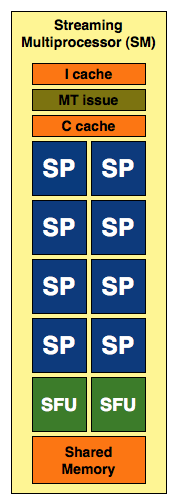
GT200 SM
In addition to the cores, each SM has a Special Function Unit (SFU) used for transcendental math and interpolation. In GT200 this SFU had two pipelines, in GF100 it has four. While NVIDIA increased general math horsepower by 4x per SM, SFU resources only doubled. The infamous missing MUL has been pulled out of the SFU, we shouldn’t have to quote peak single and dual-issue arithmetic rates any longer for NVIDIA GPUs.
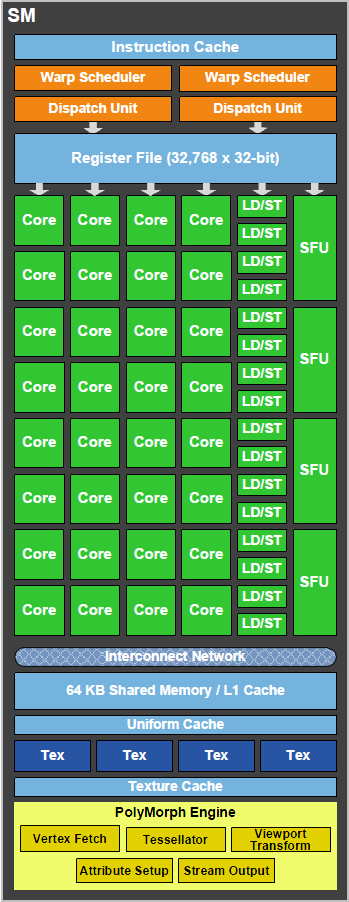
GF100 SM
NVIDIA’s GT200 had a 16KB shared memory in each SM. This didn’t function as a cache, it was software managed memory. GF100 increases the size to 64KB but it can operate as a real L1 cache now. In order to maintain compatibility with CUDA applications written for G80/GT200 the 64KB can be configured as 16/48 or 48/16 shared memory/L1 cache. GT200 did have a 12KB L1 texture cache but that was mostly useless for CUDA applications. That cache still remains intact for graphics operations. All four GPCs share a large 768KB L2 cache.
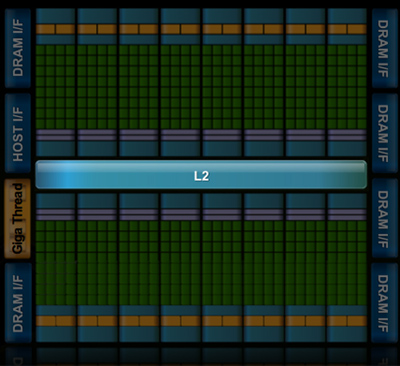
Each SM has four texture units, each capable of 1 texture address and 4 texture sample ops. We have more texture sampling units but fewer texture addressing units in GF100 vs. GT200. All texture hardware runs at 1/2 shader clock and not core clock.
| NVIDIA Architecture Comparison | G80 | G92 | GT200 | GF100 | GF100 Full* |
| Streaming Processors per TPC/GPC | 16 | 16 | 24 | 128 | 128 |
| Texture Address Units per TPC/GPC | 4 | 8 | 8 | 16 | 16 |
| Texture Filtering Units per TPC/GPC | 8 | 8 | 8 | 64 | 64 |
| Total SPs | 128 | 128 | 240 | 480 | 512 |
| Total Texture Address Units | 32 | 64 | 80 | 60 | 64 |
| Total Texture Filtering Units | 64 | 64 | 80 | 240 | 256 |
Last but not least, this brings us to the ROPs. The ROPs have been reorganized, there are now 48 of them in 6 parttions of 8, and a 64bit memory channel serving each partition. The ROPs now share the L2 cache with the rest of GF100, while under GT200 they had their own L2 cache. Each ROP can do 1 regular 32bit pixel per clock, 1 FP16 pixel over 2 clocks, or 1 FP32 pixel over 4 clocks, giving the GF100 the ability to retire 48 regular pixels per clock. The ROPs are clocked together with the L2 cache.
Threads and Scheduling
While NVIDIA’s G80 didn’t start out as a compute chip, GF100/Fermi were clearly built with general purpose compute in mind from the start. Previous architectures required that all SMs in the chip worked on the same kernel (function/program/loop) at the same time. If the kernel wasn’t wide enough to occupy all execution hardware, that hardware went idle, and efficiency dropped as a result. Remember these chips are only powerful when they’re operating near 100% utilization.
In this generation the scheduler can execute threads from multiple kernels in parallel, which allowed NVIDIA to scale the number of cores in the chip without decreasing efficiency.
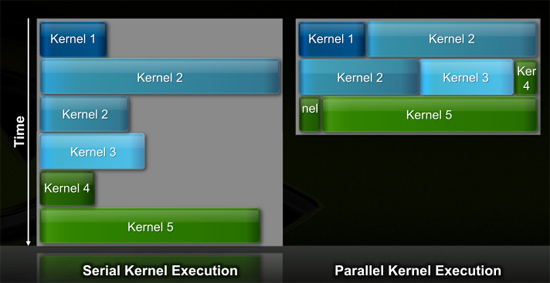
GT200 (left) vs. GF100 (right)
With a more compute leaning focus, GF100 also improves switch time between GPU and CUDA mode by a factor of 10x. It’s now fast enough to switch back and forth between modes multiple times within a single frame, which should allow for more elaborate GPU accelerated physics.
NVIDIA’s GT200 was a thread monster. The chip supported over 30,000 threads in flight. With GF100, NVIDIA scaled that number down to roughly 24K as it found that the chips weren’t thread bound but rather memory bound. In order to accommodate the larger shared memory per SM, max thread count went down.
| GF100 | GT200 | G80 | |
| Max Threads in Flight | 24576 | 30720 | 12288 |
NVIDIA groups 32 threads into a unit called a warp (taken from the looming term warp, referring to a group of parallel threads). In GT200 and G80, half of a warp was issued to an SM every clock cycle. In other words, it takes two clocks to issue a full 32 threads to a single SM.
In previous architectures, the SM dispatch logic was closely coupled to the execution hardware. If you sent threads to the SFU, the entire SM couldn't issue new instructions until those instructions were done executing. If the only execution units in use were in your SFUs, the vast majority of your SM in GT200/G80 went unused. That's terrible for efficiency.
Fermi fixes this. There are two independent dispatch units at the front end of each SM in Fermi. These units are completely decoupled from the rest of the SM. Each dispatch unit can select and issue half of a warp every clock cycle. The threads can be from different warps in order to optimize the chance of finding independent operations.
There's a full crossbar between the dispatch units and the execution hardware in the SM. Each unit can dispatch threads to any group of units within the SM (with some limitations).
The inflexibility of NVIDIA's threading architecture is that every thread in the warp must be executing the same instruction at the same time. If they are, then you get full utilization of your resources. If they aren't, then some units go idle.
A single SM can execute:
| GF100 | FP32 | FP64 | INT | SFU | LD/ST |
| Ops per clock | 32 | 16 | 32 | 4 | 16 |
If you're executing FP64 instructions the entire SM can only run at 16 ops per clock. You can't dual issue FP64 and SFU operations.
The good news is that the SFU doesn't tie up the entire SM anymore. One dispatch unit can send 16 threads to the array of cores, while another can send 16 threads to the SFU. After two clocks, the dispatchers are free to send another pair of half-warps out again. As I mentioned before, in GT200/G80 the entire SM was tied up for a full 8 cycles after an SFU issue.
The flexibility is nice, or rather, the inflexibility of GT200/G80 was horrible for efficiency and Fermi fixes that.










196 Comments
View All Comments
henrikfm - Tuesday, March 30, 2010 - link
Now it would be easier to believe only idiots buy ultra-high end PC hardware parts.ryta1203 - Tuesday, March 30, 2010 - link
Is it irresponsible to use benchmarks desgined for one card to measure the performance of another card?Sadly, the "community" tries to hold the belief that all GPU architectures are the same, which is of course not true.
The N-queen solver is poorly coded for ATI GPUs, so of course, you can post benchmarks that say whatever you want them to say if they are coded that way.
Personally, I find this fact invalidates the entire article, or at least the "compute" section of this article.
Ryan Smith - Wednesday, March 31, 2010 - link
One of the things we absolutely wanted to do starting with Fermi is to include compute benchmarks. It's going to be a big deal if AMD and NVIDIA have anything to say about it, and in the case of Fermi it's a big part of the design decision.Our hope was that we'd have some proper OpenCL/DirectCompute apps by the time of the Fermi launch, but this hasn't happened. So our decision was to go ahead with what we had, and to try to make it clear that our OpenCL benchmarks were to explore the state of GPGPU rather than to make any significant claims about the compute capabilities of NVIDIA or AMD's GPUs. We would rather do this than to ignore compute entirely.
It sounds like we didn't make this clear enough for your liking, and if so I apologize. But it doesn't make the results invalid - these are OpenCL programs and this is what we got. It just doesn't mean that these results will carry over to what a commercial OpenCL program may perform like. In fact if anything it adds fuel to the notion that OpenCL/DirectCompute will not be the great unifier we had hoped for them to be if it means developers are going to have to basically write paths optimized around NVIDIA and AMD's different shader structure.
ryta1203 - Tuesday, March 30, 2010 - link
The compute section of this article is just nonsense. Is this guy a journalist? What does he know about programming GPUs?Firen - Tuesday, March 30, 2010 - link
Thanks for this comprehensive review, it covers some very interesting topics betwen Team Green and Team Red.Yet, I agree with one of the comments here, you missed how easy that ATI 5850 and 5870 can be overlocked thanks to their lite design, a 5870 can easily deliver more or less the same performance as a 480 card while still running cooler and consumes less power..
Some people might point out that our new 'champion' card can be overlocked as well..that's true..however, doesn't it feel terrifying to have a graphic card running hotter than boiling water!
Fulle - Tuesday, March 30, 2010 - link
I wonder what kind of overclocking headroom the 470 has.... since someone with a 5850 can easily bump the voltage up a smidge, and get about a 30% overclock with minimal effort... people who tinker can usually safely reach about 1GHz core, for about a 37% overclock.Unless the 470 has a bit of overclocking headroom, someone with a 5850 could easily overclock to have superior performance, lower heat, lower noise, and lower power consumption.
After all these months and months of waiting, Nvidia has basically released a few products that ATI can defeat by just binning their current GPUs and bumping up the clockspeed? *sigh* I really don't know who would buy these cards.
Shadowmaster625 - Tuesday, March 30, 2010 - link
You're being way too kind to Nvidia. Up to 50% more power consumption for a very slight (at best) price/performance advantage? This isnt a repeat of the AMD/Intel thing. This is a massive difference in power consumption. We're talking about approximately $1 a year per hour a week of gaming. If you game for 20 hours a week, expect to pay $20 a year more for using the GTX470 vs a 5850. May as well add that right to the price of the card.But the real issue is what happens to these cards when they get even a modest coating of dust in them? They're going to detonate...
Even if the 470 outperformed the 5850 by 30%, I dont think it would be worth it. I cant stand loud video cards. It is totally unacceptable to me. I again have to ask the question I find myself asking quite often: what kind of world are you guys living in? nVidia should get nothing more than a poop-in-a-box award for this.
jujumedia - Wednesday, March 31, 2010 - link
with those power draws and the temps it reaches for daily operation i see gpu failure rates high on the gtx 480 and 470 as they are already faulty from the fab lab. Ill stick with ATI for 10 fps less.njs72 - Wednesday, March 31, 2010 - link
I been holding on for months to see what Fermi would bring in the world of GPUs. After reading countless reviews of this card i dont think its a justifyable upgrade for my gtx260. I mean yeah the performance is much higher but in most reviews of benchmarks with games like Crysis this card barely wins against the 5870, but buying this card i would need to upgrade the psu and posibly a new case for ventilation. I keep loading up Novatechs website and and almost adding a 5870 to the basket, and not pre ordering gtx480 like i was intending. What puts me off more than anything with the new nvidia card is its noise and temps. I cant see this card living for very long.Ive been a nvidia fan ever since the the first geforce card came out, which i still have tucked away in a draw somewhere. I find myself thinking of switching to ATI, but read too many horror stories about their driver implementation that puts me off. Maybe i should just wait for Nvidia to refresh its new card and keep hold of my 260 for a bit longer. i really dont know :-(
Zaitsev - Wednesday, March 31, 2010 - link
There is an error with the Bad Company 2 image mouse overs for the GTX 480. I think the images for 2xAA and 4xAA have been mixed up. 2xAA clearly has more AA than the 4xAA image.Compare GTX 480 2x with GTX 285 4x and they look very similar. Also compare 480 4x with 285 2x.
Very nice article, Ryan! I really enjoyed the tessellation tests. Keep up the good work.